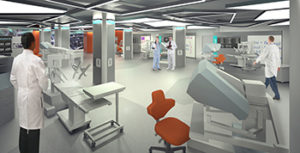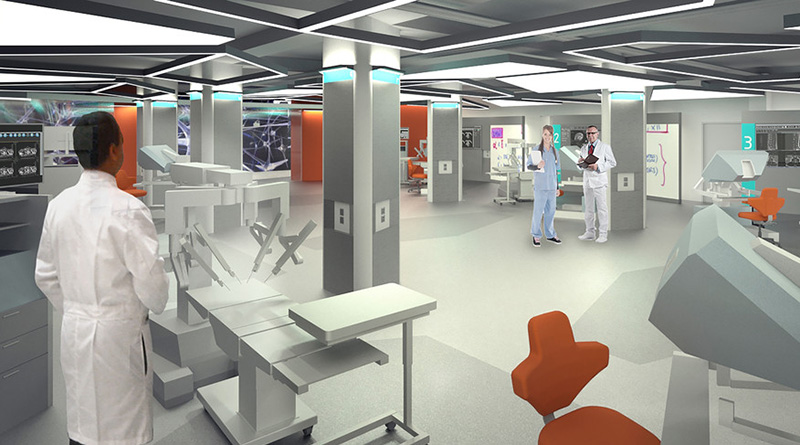University of Illinois Plans for New Surgical Training Lab

CHICAGO — The College of Medicine at the University of Illinois at Chicago (UIC) already has an international reputation. It’s the third-largest medical school in the U.S. and its Department of Surgery currently has the largest program in non-urological robotic surgery in the world as well as the single-most active living donor, liver-bowel transplant program in the world. Now, the college hopes to become one of the leading teaching hospitals for robotic systems with plans for a new surgical research and training laboratory (SRT) already underway.
Locally based Bailey Edward just finished the conceptual design phase for the project, which includes renovating about 15,947 square feet of existing basement space in the Illinois Neuropsychiatric Institute (NPI) centrally located on the college’s Chicago campus. It will primarily function as a surgical simulation lab that will provide advanced teaching and research environments to accommodate 21st century instructional formats and programs, with an end goal of creating a better patient experience.
The SRT design addresses the current higher-education trend of designing a flexible, adaptable space to be used by several departments — Neurosciences, Minimally Invasive Surgery and Anatomy, in this case — to help foster collaboration while also saving on costs. “[The three departments] wanted the space to be flexible and adaptable enough, addressing very different needs and how they are each going to use the space,” said Robin Whitehurst, AIA, NCARB, LEED AP, principal-in-charge for Bailey Edward. “We had to speak very carefully with staff, surgeons and support staff so that it would work properly.”
The approach taken in the development of the NPI Basement level was to create a centralized core to house the primary functions of the SRT Lab. After working with key stakeholders in the college, Whitehurst said that four components formulate the core of the space: the SRT Lab, the Surgical Simulation Lab, Specialized Procedures Suite and classrooms.
One thing the design team focused on is creating the sense that this is a premiere training facility. The space is envisioned as a futuristic intervention enveloping its surroundings in the benign, underused basement of a 1930s-era medical lab building. The desired aesthetic is clean and mechanical with polished surfaces, unexpected finishes and irregular geometries in sharp contrast to the existing context. Guests will enter the space from the elevator, and they will instantly get the sense that the space is very advanced and forward thinking, according to Whitehurst. The original space is very gridded with tight column spaces, so the design team intentionally hid a lot of those columns and fostered curving forms near the entry.
“We want it to look very clean and contemporary but also to express the high technology that’s going on in the space,” Whitehurst said. “Some of the existing columns will be exposed so that the rest of these curved walls look like an insertion into the existing space.”
With conceptual design completed, the college is currently fundraising, with a construction schedule still to be determined. Whitehurst said the college is extremely motivated to start on the flexible, high-tech simulation laboratory since the well-designed space will attract more students, surgeons, and financial contributors to the school to learn the minimally invasive da Vinci Surgery System.

